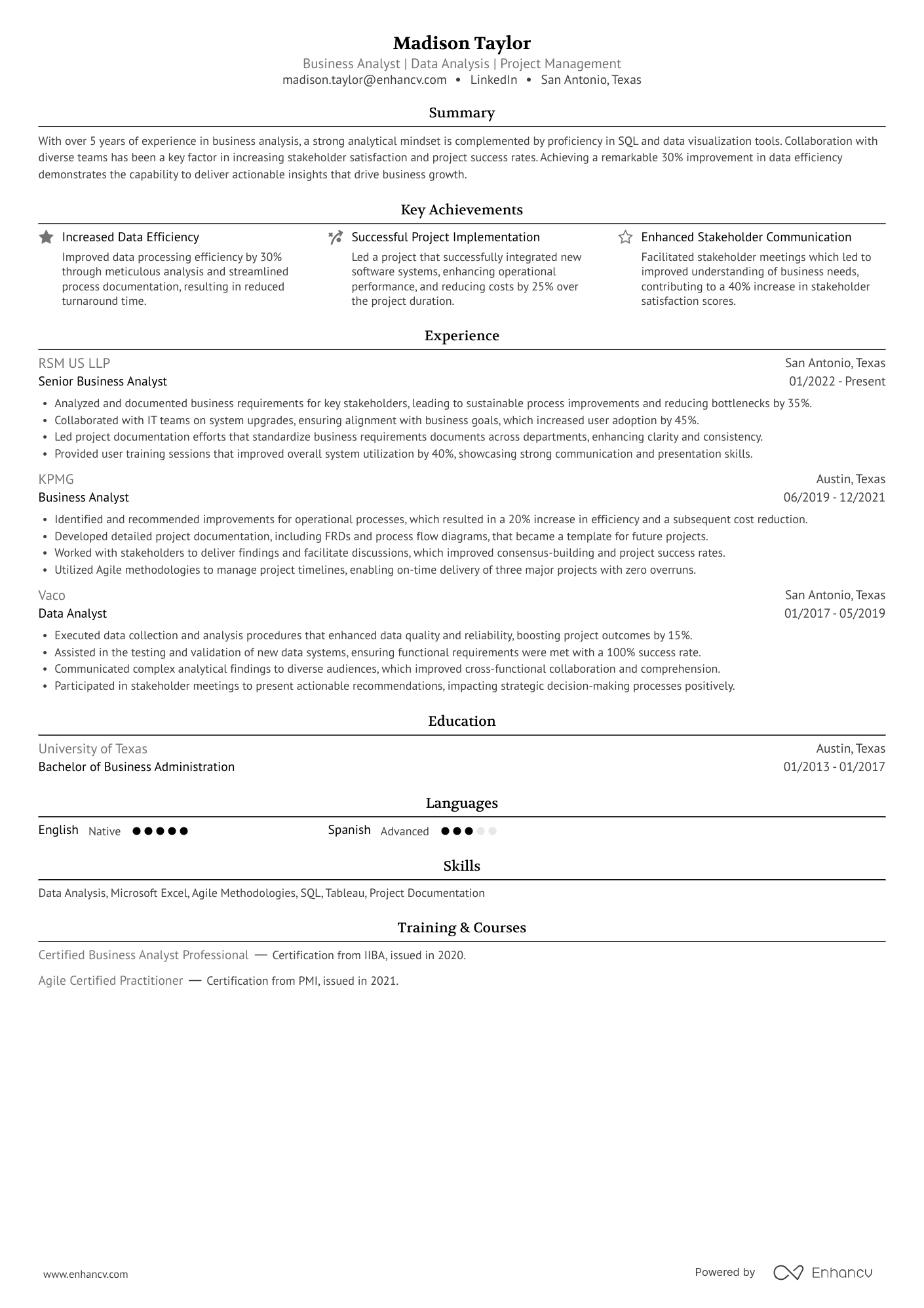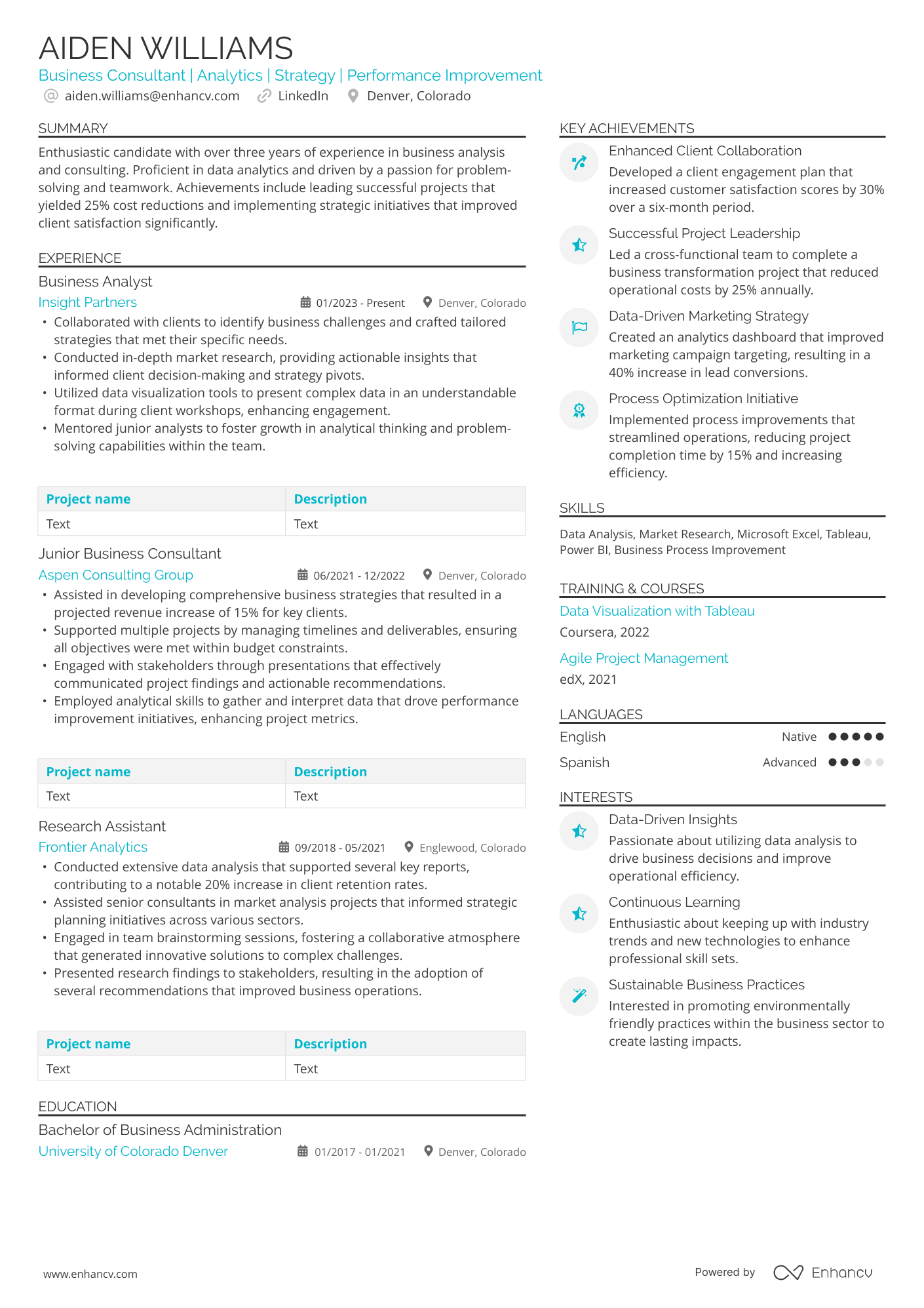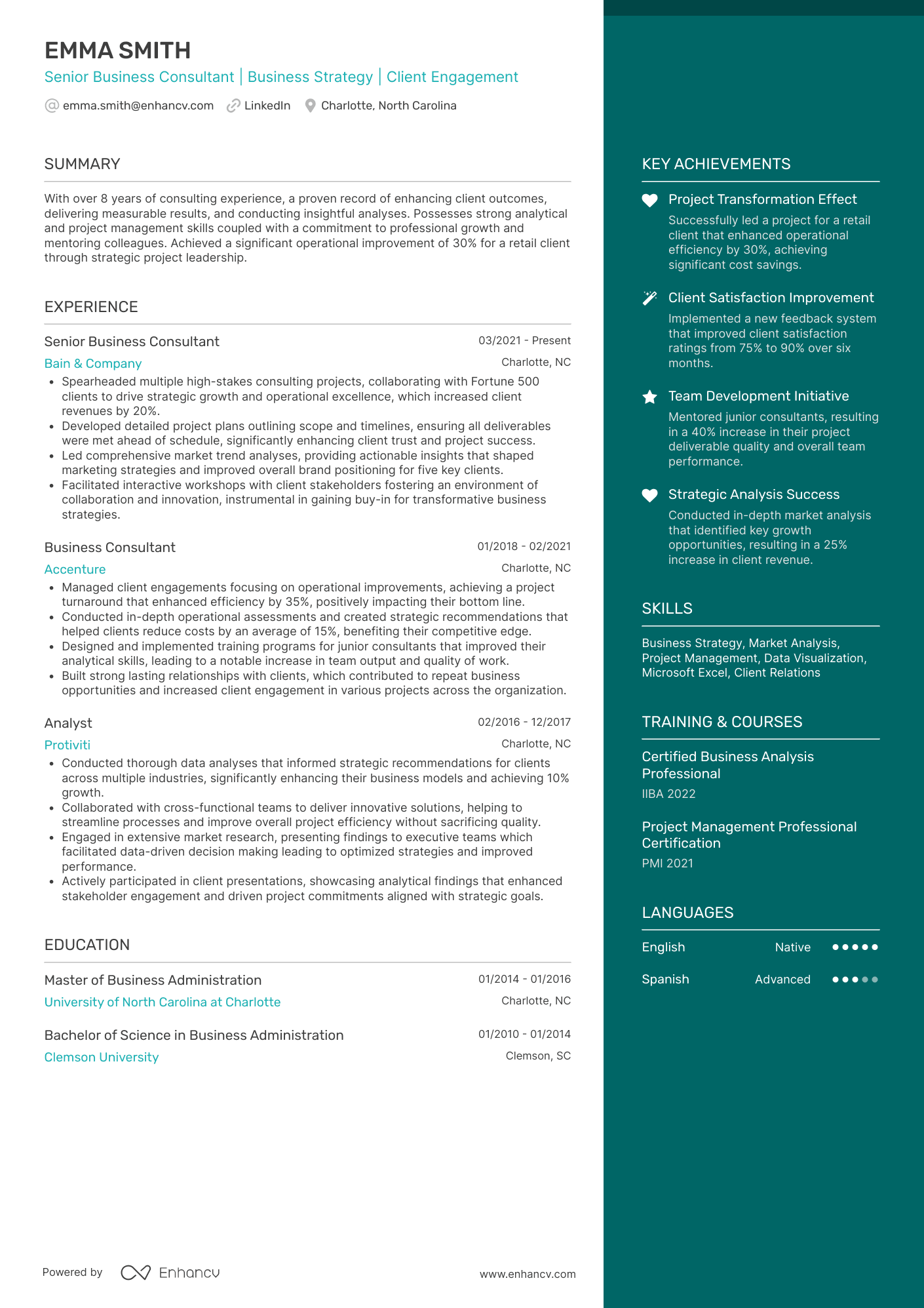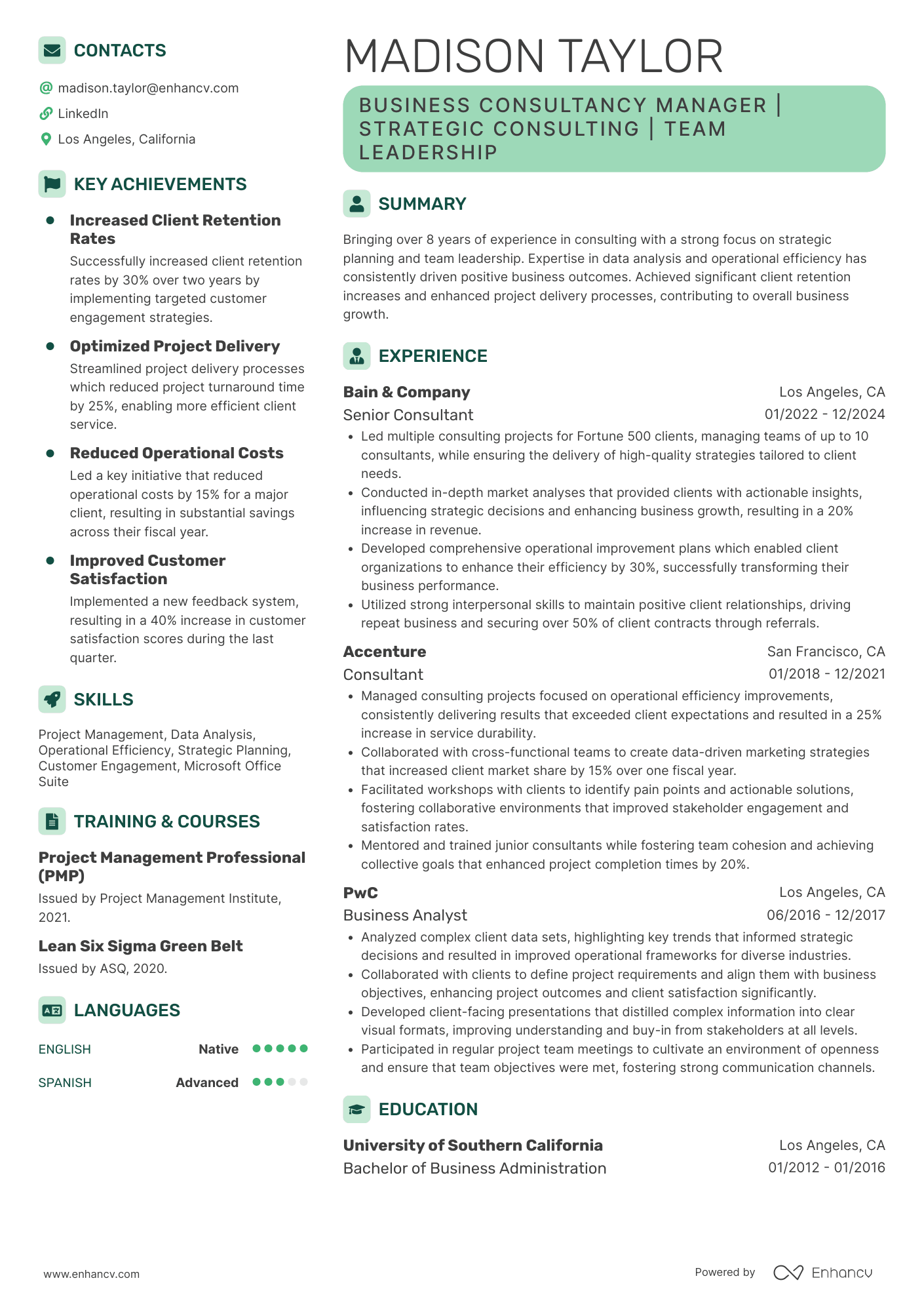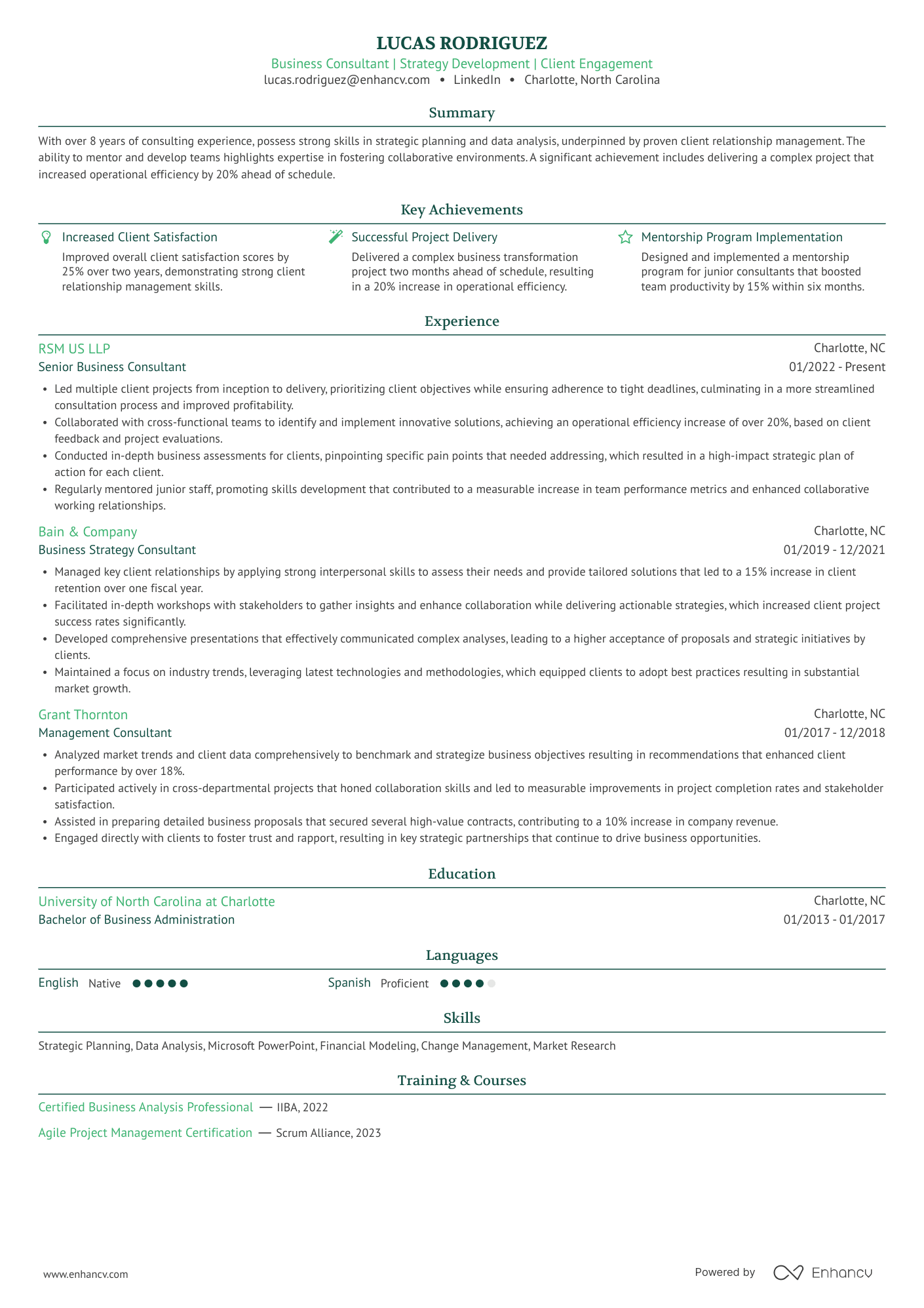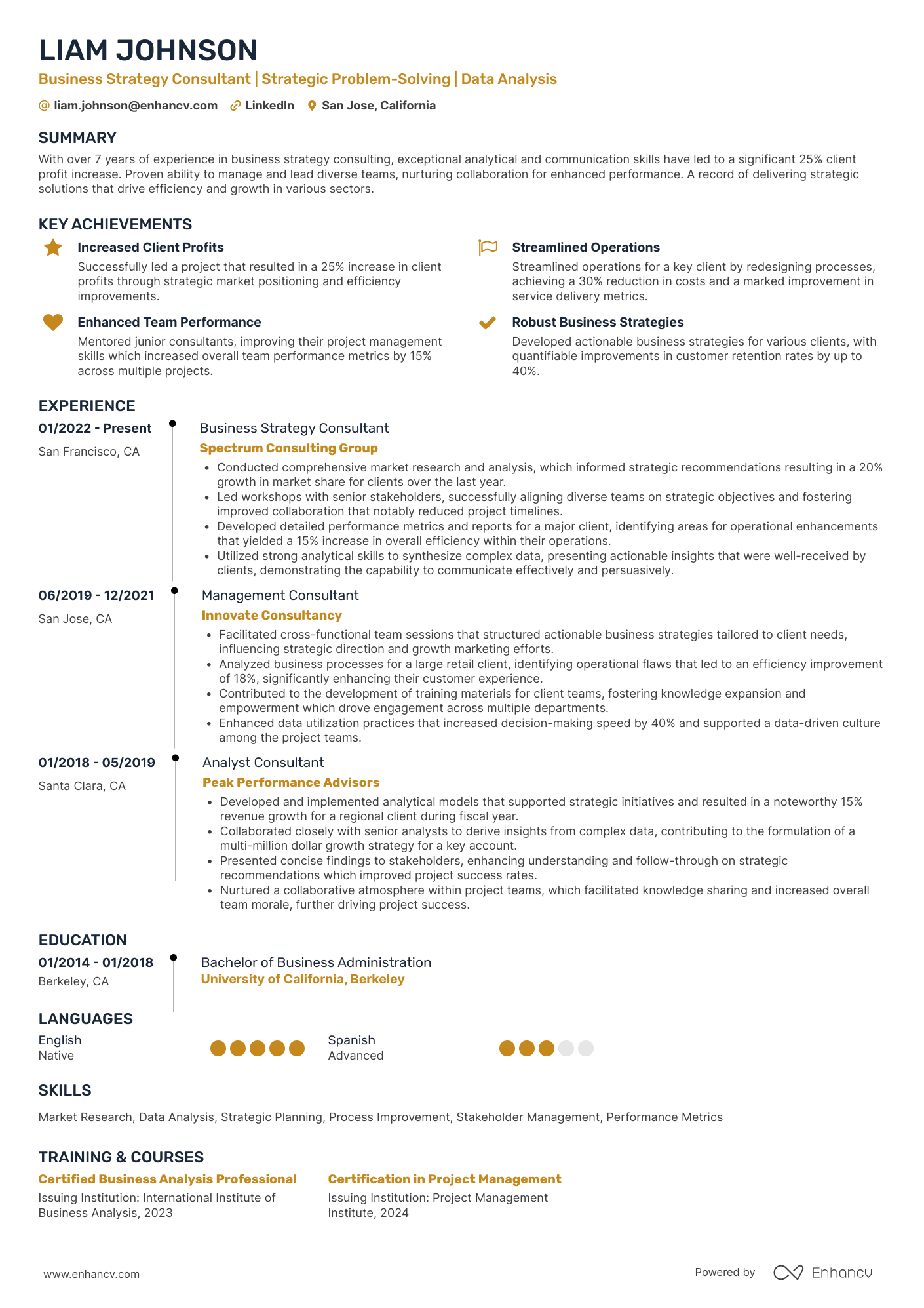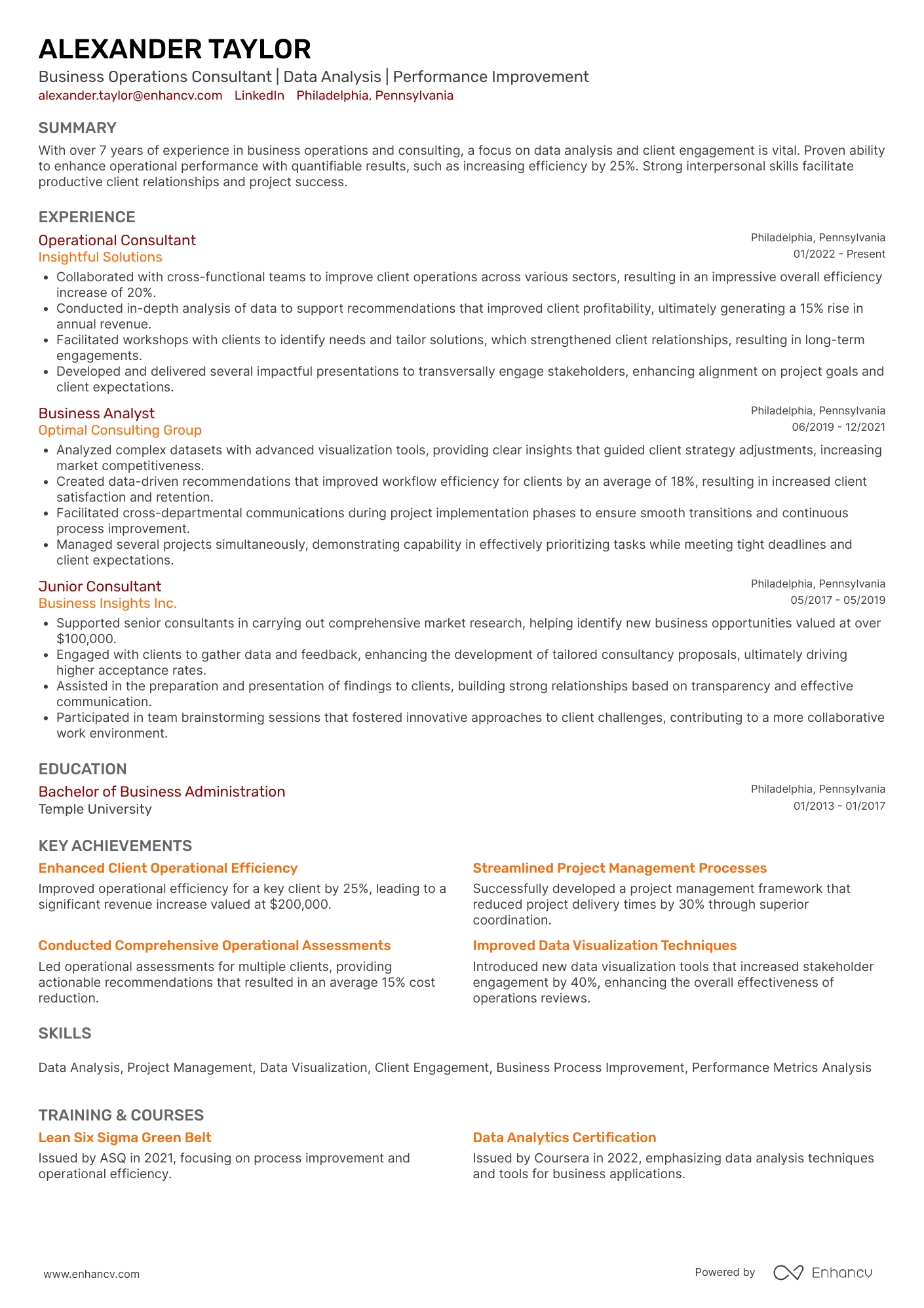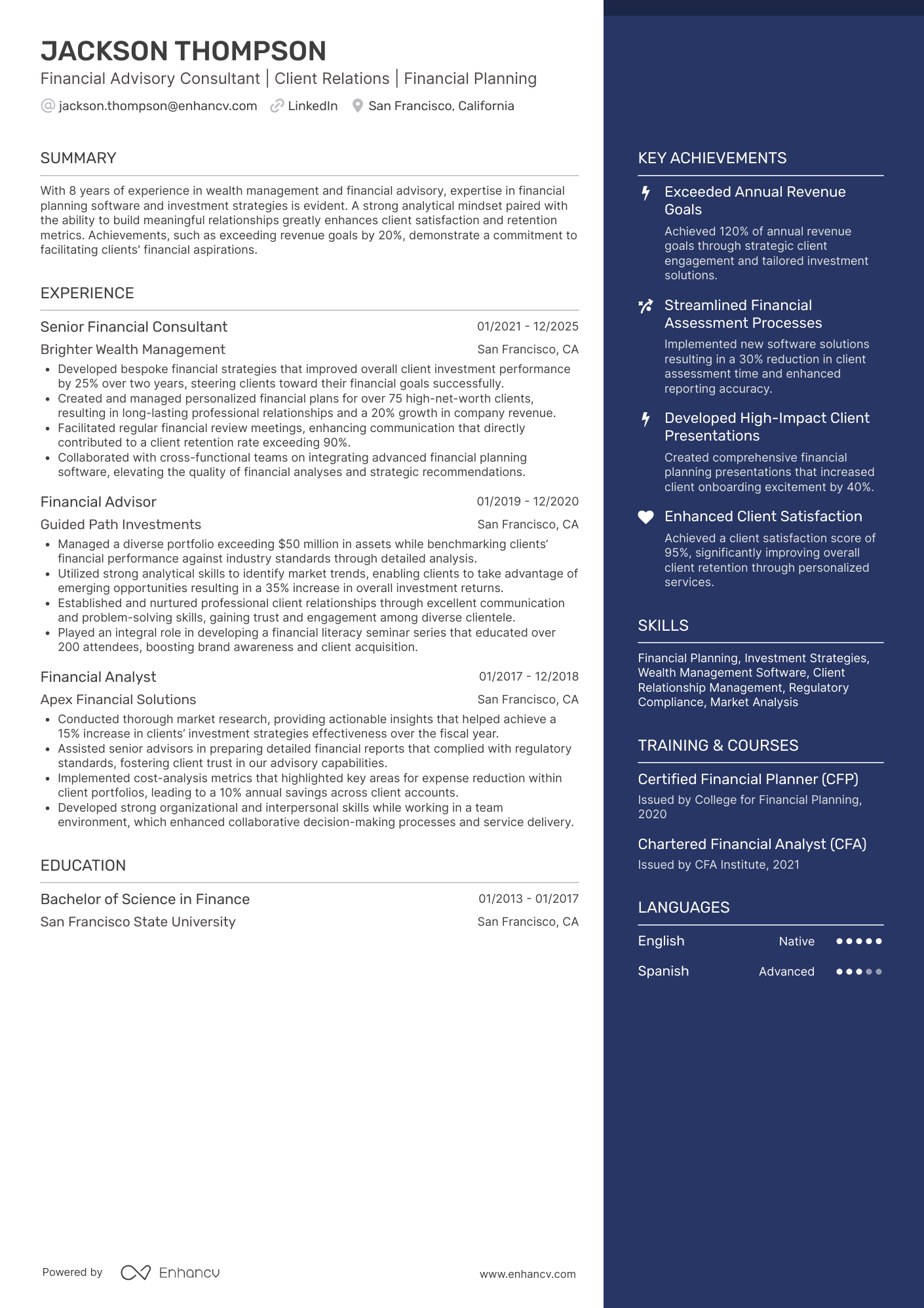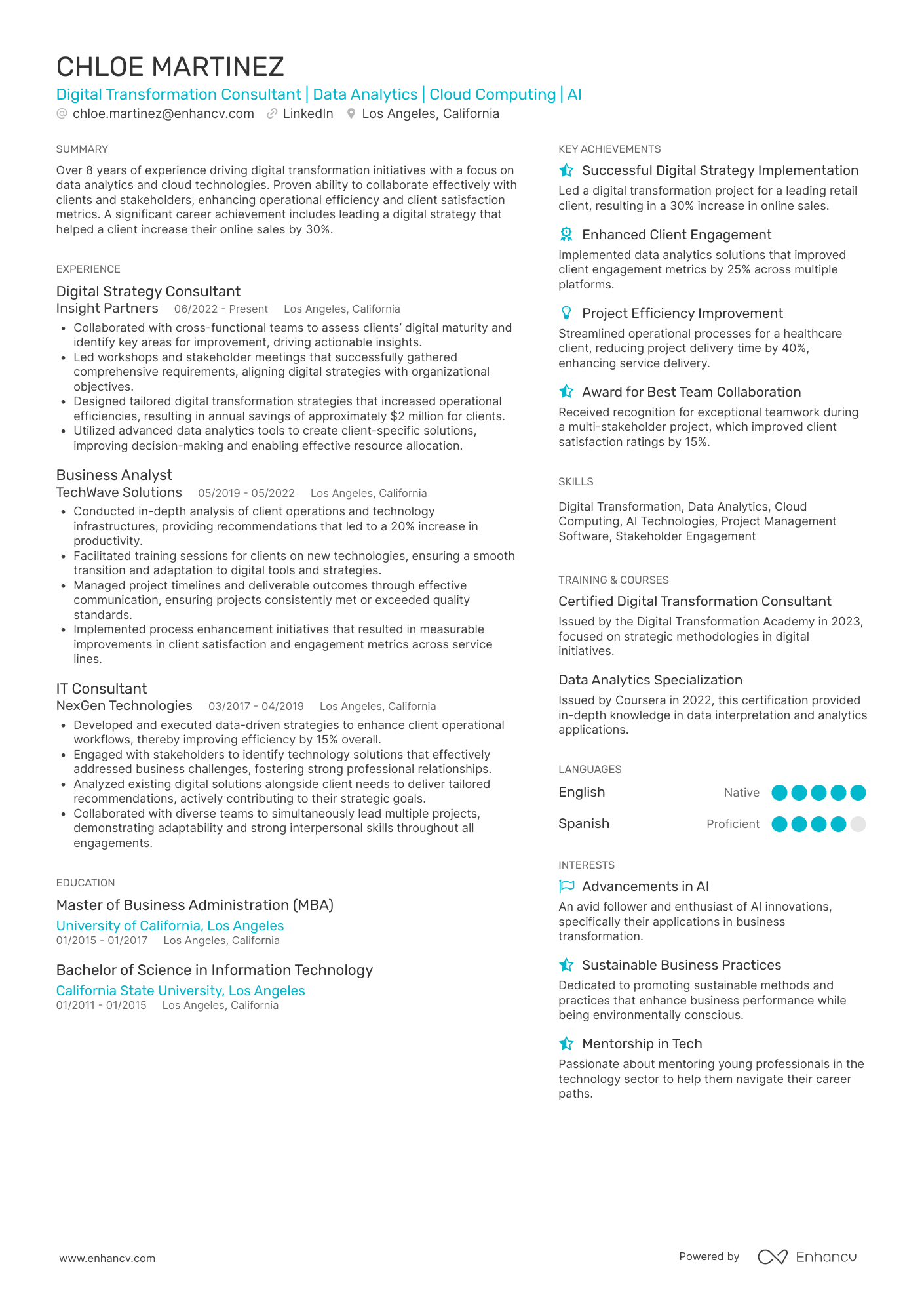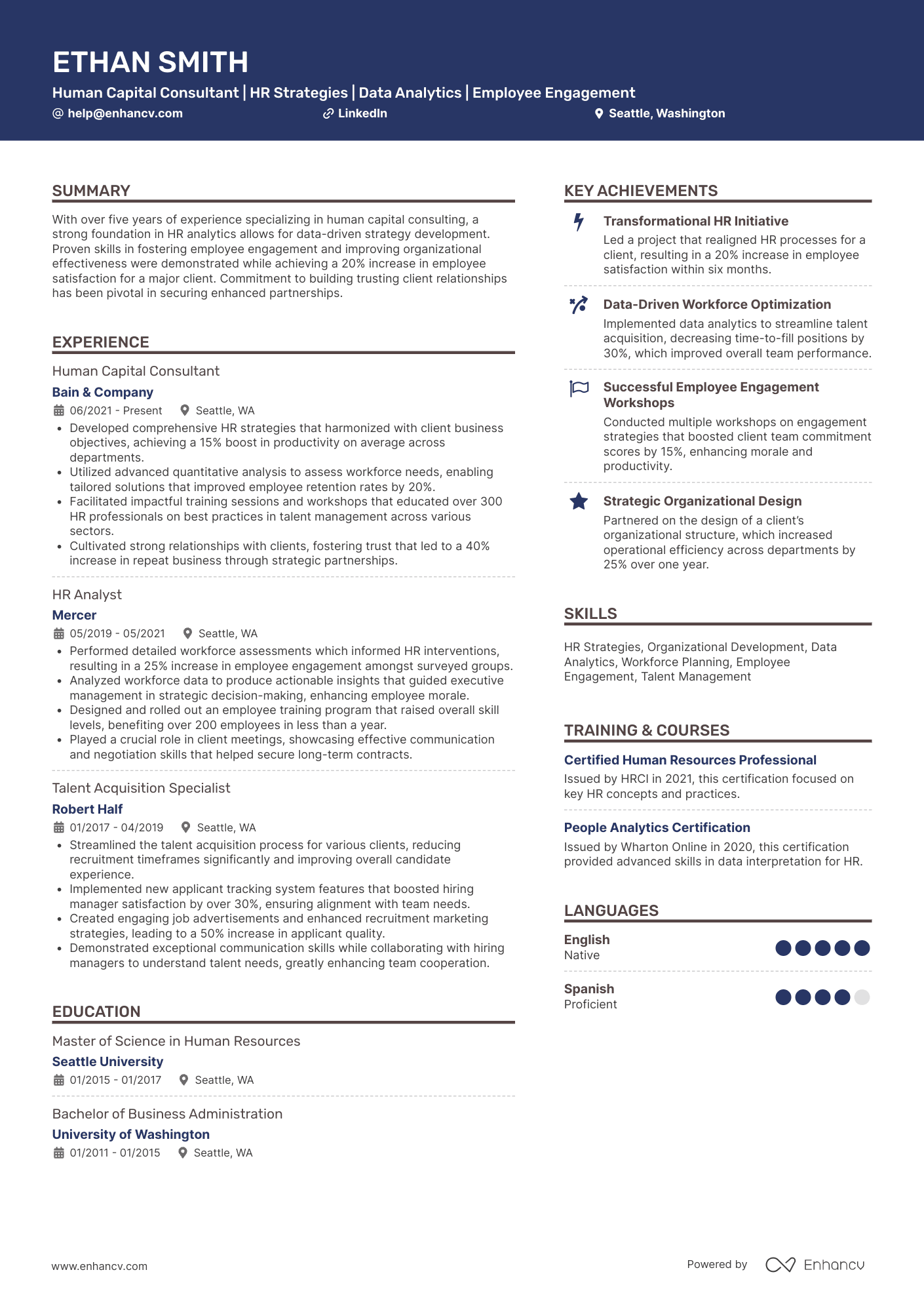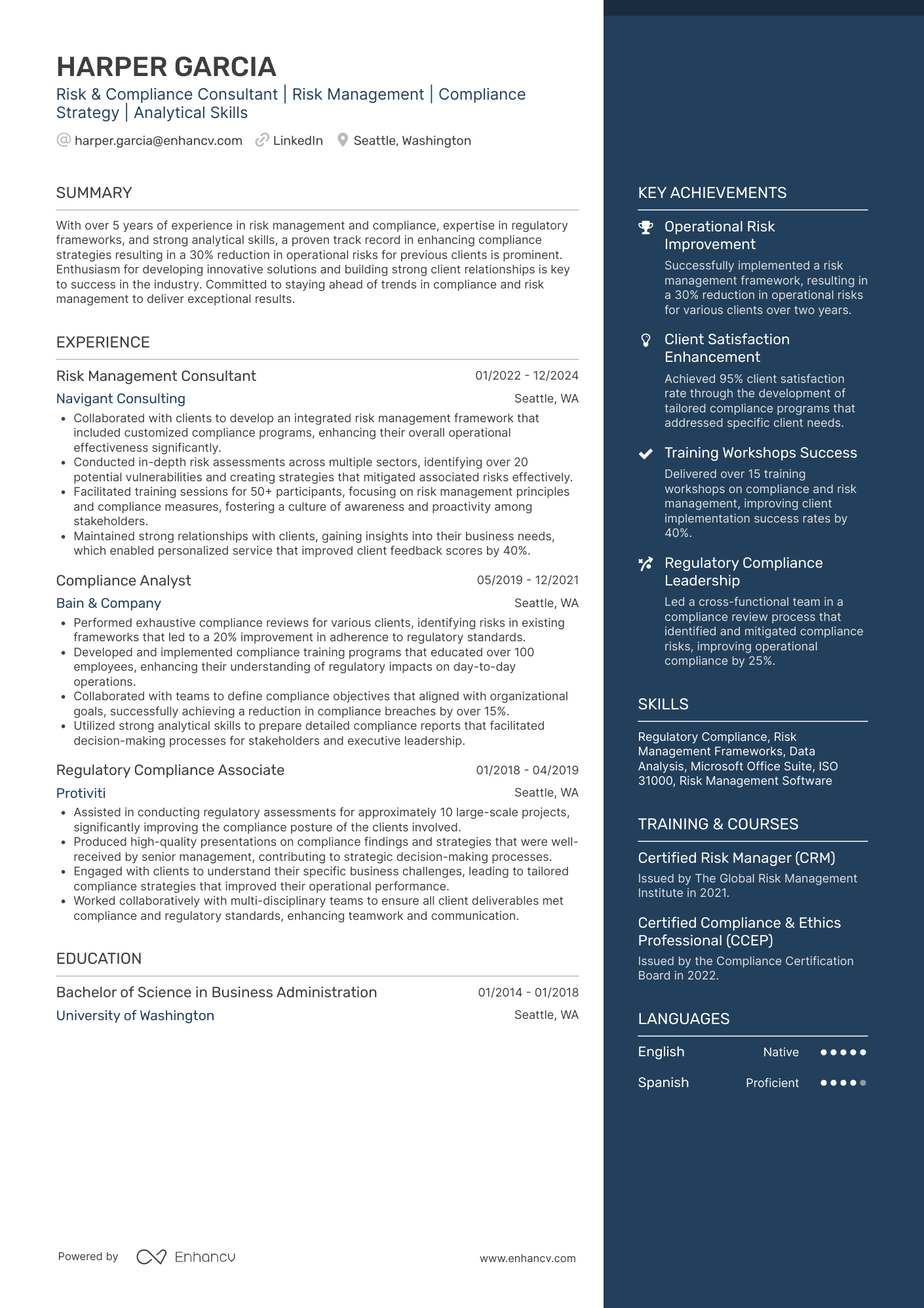In the past, business consulting used to be about delivering boring reports. Nowadays, it’s about driving complex transformational programs across financial domains. If your ambition is to land a top-tier business consulting role, then your resume needs to convey accountability for your clients’ success.
The global management consulting market is expanding. There’s a high demand for expertise in areas such as cost optimization, digital transformation, and AI strategy. This means there’s plenty of available roles, but securing one at a prestigious firm will take an impressive candidacy.
Here we'll show you how to make a resume that frames you as a creator of value. Your application will tell employers you’re a result-driven transformation specialist they need to hire right away.
Key takeaways
- Define your value proposition. Your resume must articulate your ability to deliver measurable ROI.
- Show career progression and high-stakes projects through a reverse-chronological resume. A hybrid resume format can work for career switchers.
- Relevant education and certification can give you a competitive edge.
- Quantification is key. Write about every project in terms of metrics and results.
- Have a dedicated section where you list essential consulting frameworks and tools.
- Give context to your soft skills by weaving them into your summary and experience bullet points.
First, let’s see specific business consultancy roles and what it takes to build a successful application for each.
Business consultant resume examples
By Experience
Business Analyst
- Show your ability to handle complex data sets by including examples of technical tool proficiency such as SQL, Tableau, or advanced Excel pivot tables.
- Instead of just listing analytical tasks, include measurable outcomes such as “identified $250K in annual cost savings."
- Describe how you translated technical data into actionable executive dashboards or user stories to show your communication skills.
- Detail a specific instance where you conducted a root cause analysis to reverse a negative business trend. This shows problem-solving skills.
Associate Business Consultant
- Detail your ownership of deliverables from the research phase through to implementation. This way you show your ability to manage specific project workstreams.
- Mention your role in gathering requirements and building stakeholder trust by detailing your experience in client-facing roles.
- List both specialized software and the various industry frameworks you have applied in your works. This way you show technical versatility.
- Signal advanced analytical potential by featuring contributions to "thought leadership" projects, such as internal white papers or case studies.
Senior Business Consultant
- Prove your leadership readiness through high-level strategic planning and the management of cross-functional teams.
- Showing revenue growth percentages or multi-million dollar cost reductions achieved under your direct guidance is an advantage.
- Mention stakeholder management and executive presentation skills in your experience section to show you can influence the C-suite.
- Establish professional credibility with advanced industry certifications like a PMP or Lean Six Sigma Black Belt.
Business Consultancy Manager
- Focus your summary on your track record of leading high-stakes projects to signal elite-level experience.
- Quantify your leadership by stating the number of analysts you managed and the total budget size of the engagements you directed.
- Show your exceptional client relationship management through your ability to secure repeat business and contract extensions.
- Describe how you successfully navigated project scope changes or significant market shifts. This way you convey expertise in risk mitigation.
Business Consultancy Partner
- Define yourself as a "trusted advisor" in your summary. Mention how many years of experience you have in advising high-level executives.
- Show a record of driving massive revenue growth through strategic transformation initiatives.
- Prove your seniority in high-pressure environments by showing your expertise in complex negotiation and executive-level conflict resolution.
- Mention board-level reporting and your role in shaping long-term corporate direction for major industry players.
By Role
Business Strategy Consultant
- Satisfy ATS filters for strategy-focused roles by including specific keywords such as "Competitive Analysis" and "Market Entry Strategy."
- Feature project outcomes that show long-term impact, such as post-merger integration success or five-year growth plan execution.
- Show your ability to build complex financial models and conduct due diligence for high-value mergers and acquisitions.
- Quantify your achievements with strategic metrics, such as "increased market share by 15%" or "identified $50M in potential synergies".
Business Operations Consultant
- Prove execution expertise by detailing your mastery of process improvement methodologies such as Lean Six Sigma or Agile.
- Show quantifiable results in cost reduction and efficiency increases, such as "reduced transportation costs by 32%".
- Describe instances where you identified and eliminated bottlenecks in a supply chain or internal workflow.
- Feature your experience with major ERP systems like SAP or Oracle. These are critical tools for operational transformation.
Financial Advisory Consultant
- Establish immediate authority with your most impressive financial credentials. For example, a CFA, CPA, or relevant Series licenses.
- Convey your track record in risk management by highlighting average portfolio growth rates achieved during volatile market conditions.
- Quantify the scale of your impact by including both the total assets under management and the number of clients served.
- Feature technical proficiencies in platforms like Bloomberg Terminal, Morningstar, or specialized financial reporting automation tools.
Digital Transformation Consultant
- Show your expertise in emerging technologies like AI, blockchain, or robotic process automation (RPA) to prove you are future-ready.
- Connect every technology initiative directly to a business outcome, such as "reduced hosting costs by 33%" through cloud migration.
- Highlight your leadership in cross-functional collaboration, showing how you aligned IT and business teams to achieve digital goals.
- Feature your success in user adoption and change management by including engagement metrics or training completion rates.
Human Capital Consultant
- Detail your knowledge of labor laws and EEO regulations to prove you can manage high-level organizational risk.
- Convey your impact on employee retention, using metrics like "reduced new hire turnover by 30%" through onboarding redesigns.
- Convey your technical fluency with major HRIS systems and how you leveraged data analytics for strategic workforce planning.
- Feature examples of successfully leading complex organizational change initiatives or diversity and inclusion programs.
Risk & Compliance Consultant
- Indicate your deep knowledge of regulatory standards (e.g., ISO 27001, SEC, FINRA) to immediately pass specialized technical screens.
- Highlight your experience in planning and executing internal or external audits with "zero critical findings".
- Show your ability to develop and update complex product specifications or compliance procedures within an organizational database.
- Feature soft skills like integrity and effective communication, as these are vital for liaising with regulatory agencies and educating staff.
Now, let’s move on to our resume-building guide.
What is the best business consultant resume format?
A reverse-chronological resume is the best option if you have direct consulting experience.
You can also use it if you have consistent project-based experience in a high-profile business environment, such as internal audit or corporate strategy.
What sections should go on a business consultant’s resume?
Create a lean, results-driven document that time-constrained partners or HR associates can scan quickly.
These are the essential resume sections:
- Header with contact information
- Summary/Professional Profile
- Work Experience/Consulting Engagements
- Technical Skills/Methodology Fluency
- Education
A nice-to-have additional section would be Certifications or Professional Development because it’s a quick proof of domain expertise and current knowledge.
What’s the best layout for a business consultant resume?
The resume layout should optimize for density, readability, and immediate impact. A clean, single-column resume often works best for maximizing space for your detailed project and experience bullet points.
However, if the role you target stresses technical proficiency, then a two-column layout is an excellent strategic choice. It allows you to balance proven project experience and methodology fluency (e.g., Lean, Agile) with technical competency (e.g., Tableau, SQL) at a glance.
Follow these consulting resume design rules
You deal with complex, data-rich projects. This means the design must convey professionalism and efficiency.
- Use 1-inch document margins and single spacing. Consulting resumes can run longer than one page (especially for senior roles) so optimal space usage is critical.
- Go for easily readable fonts (10–12 pt). Think Arial, Rubik, or Lato for maximum professionalism.
- Subtle accent colors are acceptable to give your application some character and style.
- Avoid complex graphics, charts, or images, as they can confuse some ATS and distract viewers from the content that matters.
Is your resume good enough?
Drop your resume here or choose a file. PDF & DOCX only. Max 2MB file size.
In the next few sections, we’ll focus on maximising your resume content.
How to write your business consultant resume experience
Your experience section must prove you’re a value generator. Hiring managers, partners, and practice leaders will scan your resume for:
- Financial impact and ROI: Quantifiable savings, revenue growth, profit margin increases, or cost avoidance (e.g., $5M cost reduction, 15% revenue lift).
- Process efficiency and scale: Improvements in operational metrics, speed, and volume (e.g., time-to-market reduction, process cycle time decreased by 30%, headcount reduction through automation).
- Strategic and technical implementation: Proven success in deploying complex systems or methodologies (e.g., successful SAP S/4HANA migration, development of a new Go-to-Market strategy).
Here is an experience entry reflecting what employers value:
Good example of a business consultant experience section
Senior Strategy Consultant
GlobalTech Solutions
- Generated $12 million in annualized savings for a major telecom client by designing and implementing a Zero-Based Budgeting (ZBB) model across three business units.
- Optimized the client’s supply chain planning process, utilizing Lean Six Sigma principles to decrease order-to-delivery cycle time by 18% and improve on-time fulfillment rates.
- Led a cross-functional team of 10 to define requirements and oversee the integration of a new Salesforce CRM, increasing sales pipeline visibility by 40% for the executive team.
- Managed the client relationship and project scope for a high-stakes engagement, ensuring 100% adherence to project milestones and securing a contract extension worth $1.5 million.
With this role, it’s all about the numbers.
How to quantify your experience on a business consultant resume
Senior consultants are impressed by metrics that make your impact tangible and tied to client KPIs.
Use numbers to show your work improved financial health, operational efficiency, or strategic execution.
Here’s how:
Quantified business consultant achievements on your resume
| How to quantify | Example bullet point |
|---|---|
| Demonstrate financial return (ROI) | Identified and executed $3.5M in recurring annual cost savings by consolidating redundant software licenses and migrating 80% of data to a public cloud platform. |
| Show process optimization and speed | Re-engineered the client’s internal approval workflow, reducing average approval time from 4 days to 4 hours (90% efficiency gain) for critical capital expenditure requests. |
| Highlight the scope and scale of projects | Advised a portfolio of 8 Fortune 500 clients on post-merger integration (PMI) strategy, impacting a combined $25 billion in assets. |
| Quantify client/stakeholder management | Delivered 50+ executive-level presentations to C-suite stakeholders, resulting in the successful rollout of a new organizational structure affecting 3,000 employees. |
| Prove methodology expertise | Managed the full lifecycle of a digital transformation program using an Agile Scrum framework, completing the MVP launch 15% under budget. |
Writing bullet points takes time. Speed up the process with Enhancv’s Bullet Point Generator.
How to tailor your business consultant resume experience
Showing the employer you speak their language and “get them” is all about how well you tailor your resume. Become a perfect match by featuring the exact methodologies, systems, and outcomes mentioned in the job description or the firm’s profile.
Here’s how:
Resume tailoring examples for business consultants
| Job description excerpt | Untailored bullet | Tailored bullet |
|---|---|---|
| “Requires expertise in SAP S/4HANA migration…” | Managed the deployment of a new ERP system for a manufacturing client. | Managed the full project scope and client coordination for an SAP S/4HANA migration, impacting $500M in annual revenue. |
| “Focus on Private Equity due diligence…” | Performed financial analysis and created synergy estimates for large M&A deals. | Conducted due diligence for Private Equity clients, modeling $50M in potential synergies for two target acquisitions. |
| “Fluency in Data Visualization (Tableau)”* | Used business intelligence tools to report on project metrics and track progress. | Developed and maintained 15+ interactive Tableau dashboards for the executive committee, improving data-driven decision-making speed by 25%. |
| “Experience with Agile & Scrum implementation.” | Led a team to complete a software development project on time. | Served as Scrum Master for a 6-person team, guiding the development of a client-facing app through 10 Sprints and achieving a 98% user satisfaction score on launch. |
Need help with customizing your application? Try Enhancv’s One-Click Tailoring Tool. Copy and paste the job description, and the integrated AI will automatically rework your resume to feature the most important keywords.
How to list your hard skills on your business consultant resume
It’s best to have a dedicated section for your hard skills. Name it “Core Consulting Competencies” or “Technical Proficiencies.”
You can also group related tools and technologies together to optimize your document for ATS parsing and readability.
So, what skills do employers expect to see on your resume?
Best hard skills for business consultants
| Category | Skills |
|---|---|
| Strategy and analysis | Market Sizing, Go-to-Market (GTM) Strategy, Financial Modeling, Due Diligence, Executive Interviewing, Hypothesis-Driven Problem Solving |
| Methodologies and frameworks | Agile (Scrum/Kanban), Lean Six Sigma (Green/Black Belt), Change Management (ADKAR), Waterfall, ITIL, Project Management (PMP) |
| ERP and CRM Systems | SAP S/4HANA, Oracle Cloud ERP, Salesforce, Microsoft Dynamics 365, Workday, ServiceNow |
| Data and visualization | Advanced Microsoft Excel (VLOOKUP, Power Query), SQL, Python (Pandas/NumPy), Tableau, Microsoft Power BI, Statistical Analysis |
| Productivity and communication | Microsoft PowerPoint (Executive Deck Creation), SharePoint, Confluence, Microsoft Project, Visio (Process Mapping) |
Including soft skills in your resume
People skills matter in business consulting, but simply listing “Leadership” and “Communication” is weak and undermines your presentation.
It’s far more effective to weave your soft skills into the various sections of your resume and connect them with real examples from your experience.
Here’s how:
Connecting soft skills to impact on business
| Soft skill | How to weave it in |
|---|---|
| Executive Communication & Presentation | In Summary: "Strategic Consultant proficient in Financial Modeling and Executive Presentation, successfully driving consensus across C-suite leadership to approve an $8M investment in cloud infrastructure." |
| Critical Thinking & Problem Solving | In Summary: "Critical Thinker and Lean Six Sigma certified practitioner who diagnosed the root cause of a 40% backlog in claims processing, implementing a solution that reduced error rates by 95%." |
| Stakeholder Management & Negotiation | In Experience: "Navigated complex stakeholder interests across Legal, Operations, and IT to achieve a unified vendor selection, negotiating 15% off the initial contract value." |
| Cross-Functional Leadership | In Experience: "Led a cross-functional team of 12 (including developers, finance analysts, and client SMEs) to deliver a new operational model within a tight 6-month deadline." |
| Adaptability & Resilience | In Certifications/Training: "Completed advanced certification in Agile Change Management, demonstrating adaptability and initiative required to restructure team workflows amid sudden project scope changes." |
Let’s move on to validating your theoretical foundation through your credentials.
How to list education on your business consultant resume
Your education can be a major selling point—especially if you have an MBA or a specialized degree in a relevant field like finance, engineering, or data science.
List your degrees in reverse-chronological order.
Key components to include:
- Degree name
- Institution
- Location
- Year of graduation
Education entry sample
Master of Business Administration (MBA),
Wharton School, University of Pennsylvania
Concentrations: Finance & Strategic Management, GPA: 3.8
Selected Coursework: Corporate Valuation, Data Analytics for Business Decisions
Leadership: VP of Management Consulting Club, 2nd Place, Global Strategy Case Competition
Bachelor of Science in Industrial Engineering,
Georgia Institute of Technology
Minor: Computer Science, GPA: 3.6 (Magna Cum Laude)
Relevant Project: Optimized campus logistics system, saving 150 labor hours annually.
Here are some strategic enhancements you can apply:
- GPA:Include your GPA if it is above 3.5 or meets the firm's stated minimum requirement.
- Honors/Awards: List academic distinctions (e.g., Magna Cum Laude, Dean's List).
- Relevant Coursework: For entry-level roles, list three to five courses directly related to consulting (e.g., Advanced Financial Modeling, Strategic Management, Econometrics).
- Clubs/Leadership: Mention high-profile involvement (e.g., President, Strategy Club; Case Competition Winner).
How to include certifications on your business consultant resume
If you hold relevant certifications, place this section after Education.
Key details to include:
- Full certificate title
- Issuing organization
- Year obtained/expiration
Let’s go over a few examples and see what makes them relevant.
Best certifications for business consultants
| Certificate | Why it matters |
|---|---|
| Project Management Professional (PMP) – Project Management Institute | Project delivery standard: Shows you understand the methodologies necessary to manage complex client engagements. |
| Certified Management Consultant (CMC) – Institute of Management Consultants | Professional validation: A globally recognized credential for consulting competence. |
| Lean Six Sigma Black/Green Belt – ASQ or accredited provider | Proficiency in statistical process control: Valued by firms focused on supply chain, process improvement, and operational excellence. |
| Specialized Cloud/Tech Certifications – AWS Certified Solutions Architect, Microsoft Azure, Salesforce Administrator | Domain expertise: Confirmation of critical hard skills, connecting strategy with technical know-how. |
| Certified Public Accountant (CPA) or Chartered Financial Analyst (CFA) | Financial acumen: Proof of strong analytical and regulatory knowledge. |
PRO TIP
If a certificate is explicitly mentioned in the job ad, then you can strategically include its acronym in your resume header, right after your name (e.g., Linda Chen, PMP). This immediately signals credibility to hiring decision-makers and reinforces your application.
The next step is to summarize everything into a few impactful sentences.
How to write your business consultant summary
Think of your resume summary as your sales pitch. It needs to be short, compelling, and convey competence.
Here’s how to write yours in four simple steps.
Quick summary writing formula
- Frame yourself strategically: Start with your title and core specialization (e.g., "Analytical Senior Strategy Consultant...").
- Mention methodology/technical mastery: Mention proficiency in a key framework or system the employer values ("...Lean Six Sigma Black Belt with 5+ years driving operational change in F500 environments.").
- Provide one notable, measurable result: Quantify your most impressive achievement to show you can create value ("...who delivered $15 million in annualized cost savings through process optimization and vendor rationalization.").
- Define your value proposition: Specify how you will benefit the employer("...able to leverage deep analytical rigor to support the Technology Practice's client acquisition and delivery goals.").
Let’s put this into practice.
Example summary
Results-oriented Management Consultant with 4 years of proven success in large-scale Digital Transformation and operational efficiency engagements. Expert in Agile Scrum and proficient in SAP S/4HANA, consistently driving measurable ROI for Fortune 100 clients. Most recently, led a project that reduced client capital expenditure by 22% through strategic vendor negotiation. Capable of leveraging executive communication skills and financial acumen to drive high-impact client strategy.
Get a resume summary that shows you can lead and deliver
Drop your resume here or choose a file.
PDF & DOCX only. Max 2MB file size.
How do I write a business consultant resume with no experience?
You’ve got the skills and know-how, but your work history lacks the title? It’s still possible to land the role with the right approach. Use a hybrid resume that puts forward your competencies, analytical rigor, and transferable experience.
Here’s how to make one:
Write a strategic summary:
Start with your transferable experience. Then list key consultant achievements. (e.g., "Detail-oriented Financial Analyst with 3 years of experience in the Tech sector. Designed and implemented a new budgeting process that saved the department $250K annually and improved forecasting accuracy by 15%. Seeking to leverage analytical rigor in a Strategy consulting role.")
Use an expanded skills section:
Right after your summary, place a dedicated skills section where you connect your competencies and methodologies with notable achievements from your transferable experience. This way, you show that you’re functionally competent and capable.
Write a relevant experience section:
Focus your bullet points on transferable consulting functions: diagnosis, solution design, and quantifiable impact. (e.g., “Led a team of four to diagnose supply chain bottlenecks, presenting a data-backed solution to senior leadership that subsequently reduced operational overhead by 12%.")
Maximise your credentials:
Expand your education section, especially if you’re a recent graduate. List relevant coursework (e.g., Valuation, Business Strategy) and academic projects (e.g., “Designed a market entry strategy for a startup, forecasting $1.5M in Year 1 revenue”). If you hold a relevant certificate, mention it in your header or summary.
Finally, let’s tackle some common resume concerns for this role.
Frequently asked questions about business consultant resumes and job applications
Even experienced business consultants get some of these wrong. Let’s make sure your application is impeccable.
What should the resume header include?
Include your name, professional title (e.g., "Strategy Consultant," "Management Consultant Associate"), your phone number, and a work-safe email address.
Don't forget about your LinkedIn profile. Senior consultants and partners would expect to see one.
How should you save and name your business consultant resume file?
Save your resume file in PDF format. This locks in your formatting, no matter where your document ends up. Though some job ads ask for WORD format resumes, so be mindful of that.
When naming your file, include your name and professional title.
Example: “SarahChenStrategyConsultantResume.pdf”
Should I write a cover letter?
Yes, absolutely. Especially if you’re applying without direct experience. Your cover letter is an opportunity to connect with recruiters and employers on a personal level. It’s where you show your passion for the role. Our recent survey confirms some recruiters prefer when applications include cover letters.
Do I need specific certifications to work as a Business Consultant?
No. However, specialized certifications (like PMP, CMC, or Lean Six Sigma Black Belt) are usually expected, especially from candidates without direct experience.
Should salary expectations appear on the resume?
No, don’t include any salary expectations in your resume or cover letter. Leave this talk for the interview stage.
How much do U.S. business consultants earn?
According to the BLS Occupational Outlook Handbook for management analysts as of May 2024:
- The median annual wage was $101,190.
- The lowest 10% earned less than $59,720.
- The highest 10% earned more than $174,140.
In conclusion
Business consultancy is about delivering measurable strategic and financial impact. Focus on creating an application that balances fluency with methodology. With proven stakeholder management and leadership skills, hiring decision-makers will want to speak to you. And don’t be shy to show your passion for driving complex solutions in your cover letter—senior leaders will surely appreciate your motivation.
